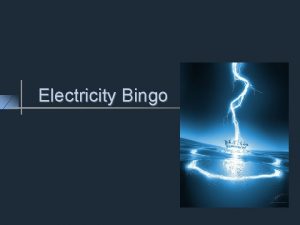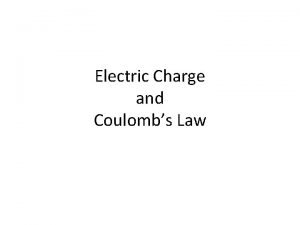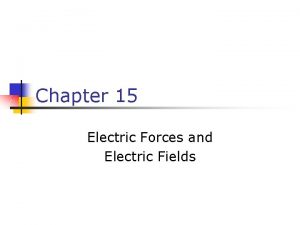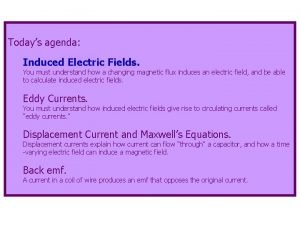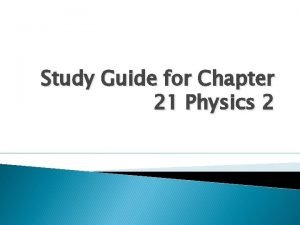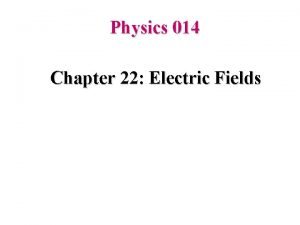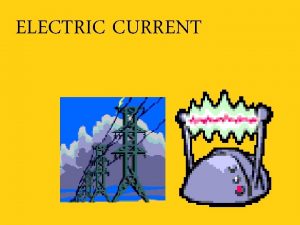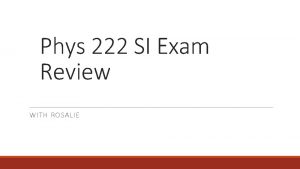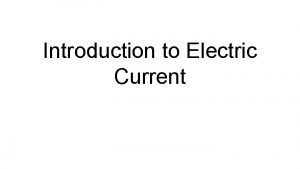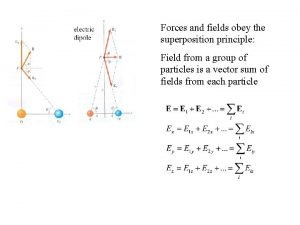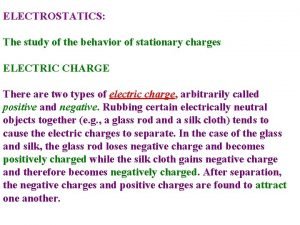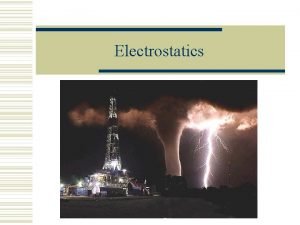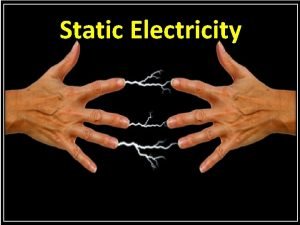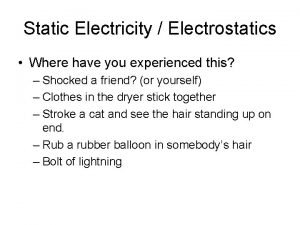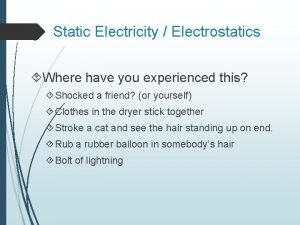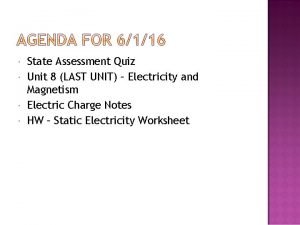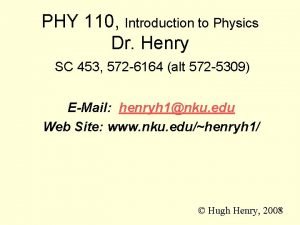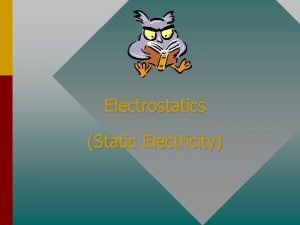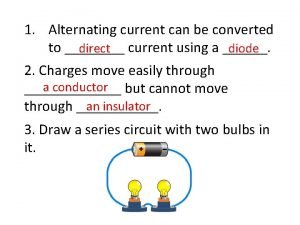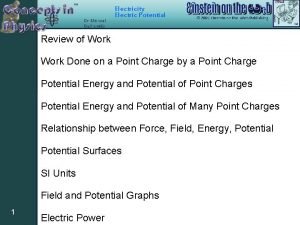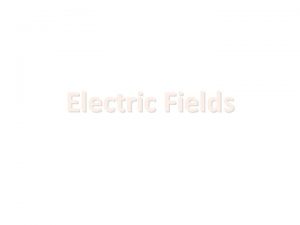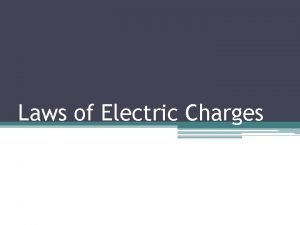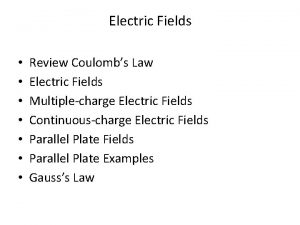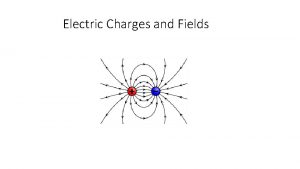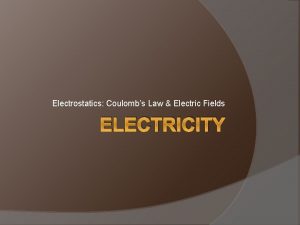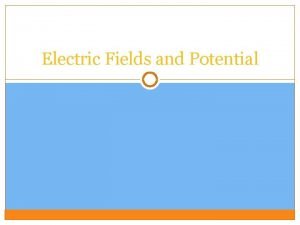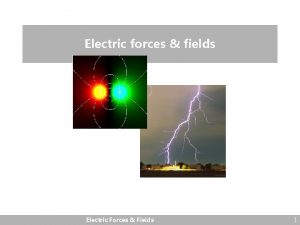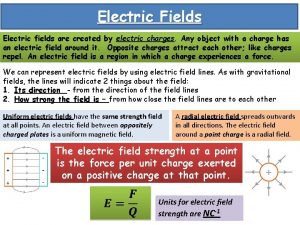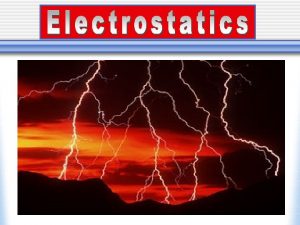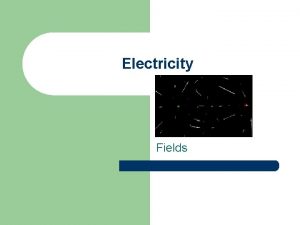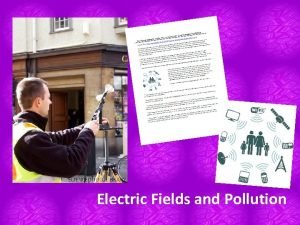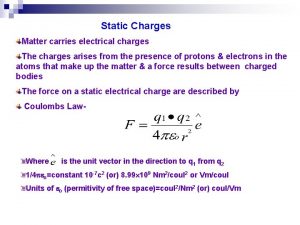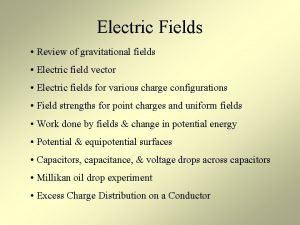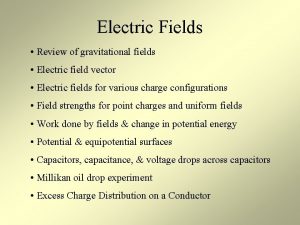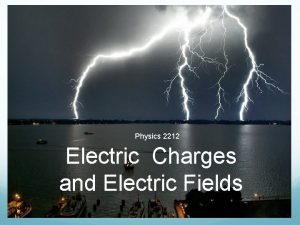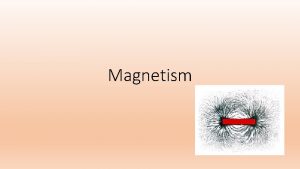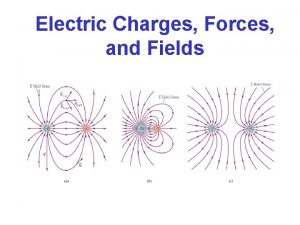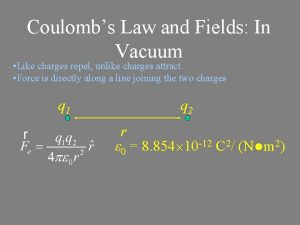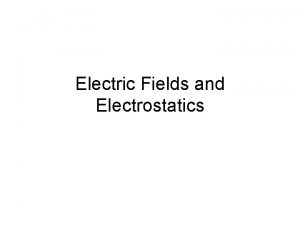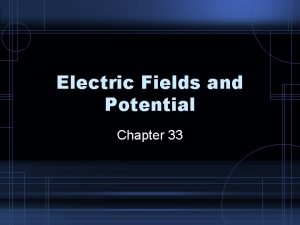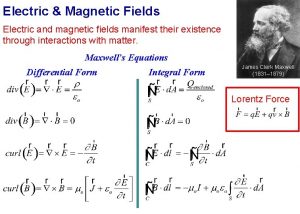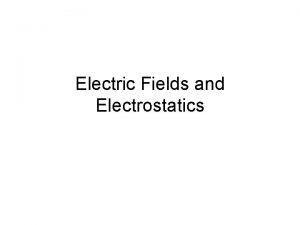Electric Fields Review Law of Electric Charges Like

















































- Slides: 49

Electric Fields

Review Law of Electric Charges Like charges repel each other; unlike charges attract. Law of Conservation of Charge In the transfer of any charge from one object to another, charge can be created or destroyed, but the total charge of a closed system remains constant.

• Basic unit of charge is the coulomb (C) • Charge on a single electron e = 1. 602 x 10 - 19 C • e can have a positive(proton) or negative(electron) value • q denotes the amount of charge, all charge is quantized in integer multiples of “e”

Conductors/Insulators Conductors – any substance in which electrons are able to move easily from one atom to another Insulators – any substance in which electrons are not free to move easily from one atom to another

Methods of Charging an Object 1) Charging by Friction (refer to electrostatic series) 2) Charging by Induced Charge Separation 3) Charging by Contact or Induction

Coulomb’s Law The force between two point charges is inversely proportional to the square of the distance between the charges and directly proportional to the product of the charges. Coulomb’s Constant

Comparison between Coulomb’s Law and Universal Gravitation Similarities • Inverse square laws • Force act along the line joining the centers of the masses or charges • Magnitude of the force is the same as the force that would be measured if all the mass or charge is concentrated at a point at the center of the sphere

Comparison between Coulomb’s Law and Universal Gravitation Differences • Electric force can attract or repel, depending on the charges involved, whereas gravitational fore can only attract • Universal gravitational constant is very small compared to coulomb’s constant which is very large

Quick Question 1 D/2 D 1) Three charges are arranged in a line q 1= 1. 5 x 10 -7 C, q 2 = -2. 3 x 10 -7 C and q 3 = -3. 5 x 10 -4 C. Determine the net force acting on the charge on the far right (q 3) 2) Three charges are arranged in a right angle triangle. q 2 = 1. 0 C at the origin, q 1=2. 0 C above q 2 and q 3=4. 0 C to the right of q 2. Determine the force on q 2.

Describing Fields Contact and non-contact Forces – objects touch/not touch each other directly/indirectly in order to exert a force on each other. Action at a distance- force between two object not in contact Michael Faraday came up with the idea of a field and applied it to the study of electrostatics. A field is a region in space that influences a mass, charge or magnet placed in that region.

Two Kinds of Fields 1) Scalar Fields -magnitude but no direction 2) Vector Fields -magnitude and direction

Electric Fields –( ) – the region in which a force is exerted on an electric charge; the electric force per unit positive charge; unit is N/C Mechanical Universe: Electric Fields Video

The electric field around a source charge will be different at different locations around the charge. • Further away from the charge, the magnitude of the force will decrease • The direction will also be different

Quick Practice 1) An electric force with a magnitude of 2. 5 N, directed to the left, acts on a negative charge of -5. 0 C. a) Determine the electric field in which the charge is located b) Calculate the electric field when the force is the same but the charge is -0. 75 C

Electric Field Lines - the continuous lines of force around charges that show the direction of the electric force at all points in the electric field Positive charge-field lines radiate outward Negative charge – field lines radiate inward

Electric Dipole – a pair of equal and opposite electric charges with centers separated by a small distance -field lines are curved and extend from the positive to the negative charge

Drawing Electric Field Lines 1) i) Electric field lines always extend from a positively charged object to a negatively charged object ii) from a positively charged object to infinity iii)from infinity to a negatively charged object. 2) Electric field lines never cross each other

3) Electric field lines are most dense around objects with the greatest amount of charge 4)At locations where electric field lines meet the surface of an object, the lines are perpendicular to the surface

Field Structure • Concepts that apply to fields at point charges also apply to conductors of all shapes • Electric field lines enter and leave a conductor perpendicular to the surface

Electric Fields near Point Sources This is the magnitude of the electric field at a distance r from a point charge.

Quick Question 1 D 1)Two point charges are 45 cm apart. The charge on q 1 is 3. 3 x 10 -9 C, and the charge on q 2 is -1. 00 x 10 -8 C a) Calculate the net electric field at point P, 27 cm from the positive charge, on the line connecting the charges b) A new charge of 2. 0 x 10 -12 C is placed at P. Determine the electric force on this new charge.

Quick Question 2 D 2) Two point charges are arranged 3. 0 cm away from the origin. q 1 = 4. 0 x 10 -6 C North of the origin and q 2 = -2. 0 x 10 -6 C East of the origin. Calculate the magnitude of the electric field at the origin.

Parallel Conducting Plates • Electric field extends from the positive plate to the negative plate • Field lines are straight, parallel to each other, and perpendicular t the planes of the charge • At any location between the plates, the electric field has the same magnitude and direction

Applications • Earth’s electric field has an average magnitude of 120 N/C • Electric field varies seasonally • An electric field mill is used to measure Earth’s electric field Treating Cancer with Electric Fields (15 mins) Electric Fields in Nature

Electric Potential Energy Electric Potential energy (EE) – the energy stored in a system of two charges a distance apart, or the energy stores in an electric field that can do work on a positively charged particle • In order to bring two like charges near each other work must be done. • In order to separate two opposite charges, work must be done.

The change in the potential energy as the charge moves through a displacement in a region where the electric field is parallel to the displacement

Quick Question 1) A charged particle moves from rest in a uniform electric field. a)For a proton, calculate the change in electric potential energy when the magnitude of the electric field is 250 N/C, the starting position is 2. 4 m from the origin, and the final position is 3. 9, from the origin b) Calculate the change in electric potential energy for an electron in the same field and with the same displacement c) Calculate the change in electric potential energy for an electron accelerated in an electric field with the same magnitude but opposite direction as in (a) and (b), and with a starting position of 2. 4 m form the origin and a final position of 5. 0 m from the origin.

Electric Potential (V) – the value in volts of potential energy per unit positive charge for a given point in an electric field; 1 V = 1 J/C • Electric potential is independent of the amount of charge at a particular location in the field • Only depends on the electric field strength • 1 V = 1 J/C=1 N m/C • 1 V/m = 1 N/C

• Electric Potential Difference( V) – the amount of work required per unit charge to move a positive charge from one point to another in the presence of an electric field • 1 V = 1 J/C=1 N m/C • 1 V/m = 1 N/C

Parallel Plates • When two parallel plates are connected across a battery, the plates become charged an electric field is established between them. • Electric field is uniform, except at the edges of the plates • Electric field depends on charge only, not on the plate separation • Electric field vectors are evenly spaced and perpendicular to plates

Quick Question 1) The cathode-ray tubes in old TV sets and computer monitors work in a way that is similar to certain parts in particle accelerators. Both devices accelerate particles in a similar way, using the uniform electric field between conducting plates. Looked at another way, the particles accelerate as they move through an electric potential difference

a) An electron leaves the negative plate of a cathode-ray tube and travels toward the positive plate. The electric potential difference between the plates is 1. 5 x 104 V. Using the law of conservation of energy and the definition of electric potential difference, calculate the speed of an electron as it reaches the positive plate. Assume electron is initially at rest, mass of an electron is 9. 11 x 10 -31 kg b) Calculate the magnitude of the electric field at a distance of 15 cm, which is at the end of the cathode-ray tube.

Electric potential due to a point charge – the electric potential is inversely proportional to the distance from the charge and proportional to the amount of charge producing the field. Recall: magnitude of electric field for a point charge

Electric Potential Due to Two Point Charges

Quick Question 1)Three charges, q 1 = 6. 0 x 10 -6 C, q 2 = -3. 0 x 10 -6 C, q 3 =-3. 0 x 10 -6 C, are located at the vertices of an equilateral triangle. a) Calculate the electric potential at the midpoint of each side of the triangle. b) Calculate the total electric potential energy of the group of charges.

Quick Question 2) Two electrons start at rest with a separation of 5. 0 x 10 -12 m. Once released, the electrons accelerate away from each other. Calculate the speed of each electron when they are very large distance apart.


Quick Question 1) An electron enters a parallel plate apparatus that is 8. 0 cm long and 4. 0 cm wide. The electron has a horizontal speed of 6. 0 x 107 m/s. The potential difference between the plates is 6. 0 x 102 V. Calculate the electron’s velocity as it leaves the plates.

The Millikan Oil Drop Experiment Fundamental physical constant – a measurable natural value that never varies and can be determined by experimentation. Elementary Charge (e) = the magnitude of the electric charge carried by a proton, equal to the absolute value of the electric charge of an electron Oil Drop explained

Millikan guessed that electric charge comes in discreet packets, so if randomly charged droplets of oil are injected into an electric field, the sum of the forces acting on the droplet would also be discreet.


Quick Question 1) An oil drop with a mass of 2. 48 x 10 -15 kg is balanced between two parallel, horizontal plates 1. 7 cm apart, maintained at a potential difference of 260 V. The upper plate is positive. Calculate the charge on the drop in coulombs and as a multiple of the elementary charge. Determine whethere is an excess or a deficit of electrons.

Quick Question 2) Due to the positive charge of Earth’s ionosphere, Earth’s surface is surround by an electric field similar to the field surrounding a negatively charged sphere. The magnitude of this field is approx. 1. 0 x 102 N/C. What charge would an oil drop with a mass of 2. 4 x 10 -15 kg need in order to remain suspended by Earth’s electric field?

Rutherford’s Scattering Experiment • Ernest Rutherford fired alpha particles at a thin sheet of gold foil. • Alpha particles have a positive charge and so does the nucleus of a gold atom, hence they repel each other and the alpha particles are scattered when they pass close by. • The alpha particles produce a tiny spark of light when they hit a fluorescent screen which can then be detected.

Rutherford fired alpha particles at gold foil and was surprised by the results. He developed the nuclear model of the atom because: (a) Most of the alpha particles went through (b) Most of the alpha particles bounced back (c) A few of the alpha particles went through (d) A few of the alpha particles bounced back

Rutherford fired alpha particles at gold foil and was surprised by the results. He developed the nuclear model of the atom because: (a) Most of the alpha particles went through (b) Most of the alpha particles bounced back (c) A few of the alpha particles went through (d) A few of the alpha particles bounced back He expected the alpha particles to go right through the foil, but only 1 out of 8000 particles were deflected straight back! positive matter must be concentrated in very small space!



Scattering Simulation
 Like charges blank and opposite charges blank
Like charges blank and opposite charges blank Electric charges and electric forces lesson outline
Electric charges and electric forces lesson outline Electric forces and fields concept review
Electric forces and fields concept review Law of electric charges
Law of electric charges Red fields
Red fields Chapter 16: electric forces and fields answers
Chapter 16: electric forces and fields answers Electric fields quiz
Electric fields quiz Conceptual physics chapter 33
Conceptual physics chapter 33 Electric fields
Electric fields Electric fields
Electric fields Induced electric field
Induced electric field Physics chapter 21 study guide answers
Physics chapter 21 study guide answers Electric currents and magnetic fields
Electric currents and magnetic fields Electric currents and magnetic fields
Electric currents and magnetic fields Electric field for a disk
Electric field for a disk An electric current is the net movement of
An electric current is the net movement of The figure shows three electric charges labeled
The figure shows three electric charges labeled What is the continuous flow of electric charge?
What is the continuous flow of electric charge? Electric field superposition
Electric field superposition Study of stationary electric charges is
Study of stationary electric charges is Electron volt
Electron volt Electron charge
Electron charge Two 40 gram masses each with a charge
Two 40 gram masses each with a charge The buildup of electric charges on an object
The buildup of electric charges on an object Joules in us units
Joules in us units Like charges attract or repel
Like charges attract or repel What kind of circuit is this
What kind of circuit is this Like charges attract or repel
Like charges attract or repel Like charges attract or repel
Like charges attract or repel The law of charges
The law of charges Newton's first law and second law and third law
Newton's first law and second law and third law Newton's first law of motion
Newton's first law of motion Boyle's law charles law avogadro's law
Boyle's law charles law avogadro's law Constant in avogadro's law
Constant in avogadro's law Potential energy equation
Potential energy equation Potential energy in uniform electric field
Potential energy in uniform electric field Electric field lines
Electric field lines Electric potential and electric field
Electric potential and electric field A suitable electric pump in an electric circuit is a
A suitable electric pump in an electric circuit is a Chapter 21 electric charge and electric field
Chapter 21 electric charge and electric field Chapter 21 electric charge and electric field
Chapter 21 electric charge and electric field K constant unit
K constant unit Chapter 21 electric charge and electric field
Chapter 21 electric charge and electric field Electric potential to work
Electric potential to work Chapter review motion part a vocabulary review answer key
Chapter review motion part a vocabulary review answer key Ap gov final review
Ap gov final review Narrative review vs systematic review
Narrative review vs systematic review What is inclusion and exclusion
What is inclusion and exclusion Narrative review vs systematic review
Narrative review vs systematic review Would rather negative form
Would rather negative form
